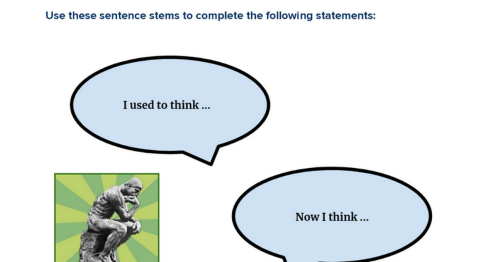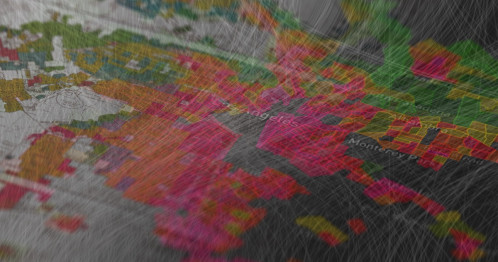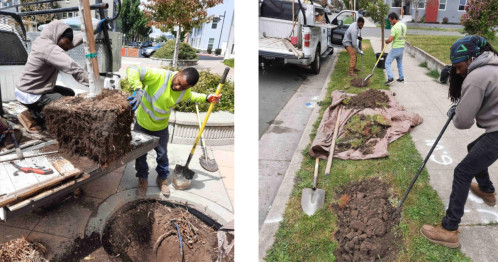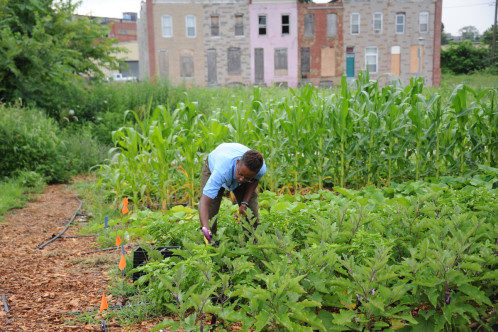This work by New American History is licensed under a Attribution-NonCommercial-ShareAlike 4.0 (CC BY-NC-SA 4.0) International License. Permissions beyond the scope of this license may be available at newamericanhistory.org.
Not Even Past: Redlining & Public Health
View Student Version
Standards
C3 Framework:D2.His.3.6-8. Use questions generated about individuals and groups to analyze why they developed, and the developments they shaped, are seen as historically significant.D2.His.3.9-12. Use questions generated about individuals and groups to assess how the significance of their actions changes over time and is shaped by the historical context.
National Council for Social Studies:Theme 2 - TIME, CONTINUITY, AND CHANGETheme 5 - INDIVIDUALS, GROUPS, AND INSTITUTIONS
National Geography Standards: Standard 1 - How to use maps and other geographic representations, geospatial technologies, and spatial thinking to understand and communicate informationStandard 12 - The processes, patterns, and functions of human settlement
College Board AP U.S. History (Fall 2020):HISTORICAL THINKING SKILLS COVERED:SKILL 4.A – Identify and describe a historical context for a specific historical process or development.SKILL 5.A: Identify patterns or connections between historical developments.HISTORICAL DEVELOPMENTS COVERED:TOPIC 8.9 - The Great Society:KC-8.2.III.B.i - Liberal ideas found expression in Lyndon Johnson’s Great Society, which attempted to use federal legislation and programs to end racial discrimination, eliminate poverty, and address other social issues.TOPIC 8.15 - Continuity & Change in Period 8:KC-8.2.I - Seeking to fulfill Reconstruction-era promises, civil rights activists and political leaders achieved some legal and political successes in ending segregation, although progress toward racial equality was slow.
College Board AP Human Geography (Fall 2020):COURSE SKILLS COVERED:SKILL 2: Spatial Relationships - Analyze geographic patterns, relationships, and outcomes in applied contexts.SKILL 3: Data Analysis - Analyze and interpret quantitative geographic data represented in maps, tables, charts, graphs, satellite images, and infographics.REQUIRED COURSE CONTENT:TOPIC 6.8 - Urban Sustainability:IMP-6.D.1 - Praise for urban design initiatives includes the reduction of sprawl, improved walkability and transportation, improved and diverse housing options, improved livability and promotion of sustainable options. Criticisms include increased housing costs, possible de facto segregation, and the potential loss of historical or place characterTOPIC 6.10 - Challenges of Urban Changes:SPS-6.A.1 - As urban populations move within a city, economic and social challenges result, including: issues related to housing and housing discrimination such as redlining, blockbusting, and affordability; access to services; rising crime; environmental injustice; and the growth of disamenity zones or zones of abandonment.
EAD RoadmapTheme: Institutional and Social Transformation Design Challenge: Motivating Agency, Sustaining the Republic
Suggested Grade Levels:High School (9-12), especially Advanced Placement U.S. History or AP Human Geography courses
Suggested Timeframe:Two 90-minute class periods
Suggested Materials:Internet access via laptop, tablet or mobile device, projection screen
Key Vocabulary
Dole - the act of giving out food, clothing, supplies, or money to the needy; doling out or distributing needed goods or services
Food desert - an area with limited access to affordable, nutritious food
Food insecurity - lack of consistent access to enough food for an active, healthy life
Home Owners’ Loan Corporation (HOLC) - an agency created in 1933 by U.S. President Franklin D. Roosevelt’s New Deal that attempted to prevent foreclosures by refinancing home mortgages in default; created a color-coded grading system that assessed the credit-worthiness of city neighborhoods
The New Deal - President Franklin D. Roosevelt’s program to help solve the economic problems triggered by the Great Depression
Redlining - the practice of mortgage lenders drawing red lines around portions of a map to indicate areas or neighborhoods in which they do not want to make loans.
Social Vulnerability - the potential negative effects on communities caused by external stresses on human health
Social Vulnerability Index - a measurement of social vulnerability that uses U.S. Census data
StoryMap - a web-based visualization integrating maps, text, images, and multimedia elements
Urban heat island - a phenomenon where a city or section of a city experiences much warmer temperatures than nearby rural areas
Read for Understanding
Teacher Tips:
This Learning Resource includes language in the body of the text to help adapt to a variety of educational settings, including remote learning environments, face-to-face instruction, and blended learning.
If you are teaching remotely, consider using videoconferencing to provide opportunities for students to work in partners or small groups. Digital tools such as Google Docs or Google Slides may also be used for collaboration. Rewordify and WordtuneRead help make a complex text more accessible for those reading at a lower Lexile level while still providing a greater depth of knowledge.
This Learning Resource uses maps from the research project Mapping Inequality: Redlining in New Deal America. The maps capture the color-coded system created in the 1930s by the Home Owners’ Loan Corporation to determine which city neighborhoods were good credit risks for home loans. The HOLC data helped set the rules for 100 years of real estate practice and helps explain the social and economic inequality that has existed in U.S. cities since the Great Depression. As a companion to “Mapping Inequality”, this resource also uses “Social Vulnerability and the Legacy of Redlining”, a digital narrative that includes maps and data that connect the racial residential segregation policies that started in the 1930s with the disparities in people’s health today.
This Resource also uses Bunk Connections, a feature that connects two articles on Bunk through their shared idea, place, persons, or time period.
In addition, this Learning Resource uses Turn and Talk to allow students to work with an “elbow partner” for brief collaborations. In addition, this Learning Resource uses “Thinking Routines” from Project Zero, a research center at the Harvard Graduate School of Education that has developed learning strategies that encourage students to add complexity to their thought processes. For an overview of Project Zero’s methodology, you may want to read its Exploring Complexity Bundle. Specifically for this lesson, students will use these thinking routines: Take Note, I Used To Think… Now I Think….
Also, this Learning Resource uses the Right Question Institute’s Question Formulation Technique. It is a structured method that students can use to generate and improve questions.
Lastly, this Learning Resource follows a variation of the 5Es instructional model, and each section may be taught as a separate learning experience, or as part of a sequence of learning experiences. We provide each of our Learning Resources in multiple formats, including web-based and an editable Google Doc for educators to teach and adapt selected learning experiences as they best suit the needs of your students and local curriculum. You may also wish to embed or remix them into a playlist for students working remotely or independently.
For Students:
The novel coronavirus pandemic has worsened many racial health inequities that existed well before this public health crisis. Americans of color have disproportionately been infected by and died from COVID-19. They are more likely to have underlying health conditions that increase the risk of severe illness from COVID-19. While the pandemic has pushed racial health inequities into the national spotlight, the underlying differences in social, economic, and environmental conditions that give rise to inequities in COVID-19 infection, transmission, and severe illness are far from new. This learning resource explores the connections between redlining and public health.
Engage
How can where you live affect your health?
In a small group of three or four as directed by your teacher, use the Question Formulation Technique to explore the following QFocus (Question Focus) prompt. (Note: If working remotely, you may use breakout rooms through videoconferencing, or share via a collaborative document such as Google Docs or Google Slides.)
Where you live affects your health.
After completing Steps 1 - 4, have each group choose their best questions, using Step 5. Ask a representative from each group to share that question.
After participating in the QFT, reflect on your learning in your group using the “I Used to Think...Now I Think” Thinking Routine:
- I used to think ________ about how where you live affects your health.
- Now, I think _______ about how where you live affects your health.
BACKGROUND: During the Great Depression, the federal government created the Home Owners’ Loan Corporation (HOLC) to help homeowners. The HOLC created a mapping system for more than 200 cities that identified the safest and riskiest neighborhoods for doling out housing loans. The mapping system used the practice of redlining and favored white residents over Black residents and immigrants. Today, many of the same areas that were redlined are experiencing negative health outcomes.
To more clearly understand the connection between redlining and health outcomes, as well as the narrative map that you will analyze, called “Not Even Past: Social Vulnerability and the Legacy of Redlining,” read the introduction independently.
Then, answer these questions in a small group as directed by your teacher:
- How is racial residential segregation related to health outcomes?
- How did the Home Owners' Loan Corporation redline neighborhoods, and how has this led to health disparities?
- What will the two sides of the map show?
Your teacher may ask you to record your answers on an exit ticket.
Explore
How are redlined areas of American cities more socially vulnerable?
The legacy of racial residential segregation and redlining includes disparities in educational opportunities, transportation infrastructure, and access to healthcare. The “Not Even Past” map connects redlining data from the 1930s to present-day health, economic, and demographic data from the Center for Disease Control and the U.S. Census. It uses the CDC’s Social Vulnerability Index, which measures how well a community can prepare for, respond to, and recover from human and natural disasters.
Take a few minutes to explore the map, including the ways data is visualized.
After you’ve explored, examine the link between social vulnerability and the legacy of redlining by making a copy and completing this Data Organizer.
Your teacher may ask you to record your answers on an exit ticket.
Explain
How has the practice of redlining affected public health and safety?
This Bunk Collection contains resources that delve deeper into the long-term effects of redlining on urban areas, such as air pollution, increased flooding, food deserts, increased temperatures, and more.
From the collection, choose 3 resources that interest you. Then, make a copy and complete this 3-2-1 graphic organizer as you read, one for each item.
After you complete all three of the graphic organizers, share your ideas within small groups or with the whole class.
If working remotely, you may use breakout rooms through videoconferencing or share via a collaborative document such as Google Docs or Google Slides.
Your teacher may ask you to record your answers on an exit ticket.
Elaborate
How is redlining linked to food insecurity and urban heat islands?
Urban neighborhoods that were redlined starting in the 1930s face present-day challenges that have been linked to the practice. Two such social and environmental challenges are food insecurity and urban heat islands. What specifically caused these challenges and how are they impacting people in redlined neighborhoods?
To learn more, explore this Bunk Connection by reading “From Food Deserts to Supermarket Redlining” and “How Decades of Racist Housing Policy Left Neighborhoods Sweltering.”
Before you read, review the questions in the “Take Note” Thinking Routine. After you read, you will choose one of the following questions to answer. Don’t try to take notes as you read; focus instead on becoming fully engaged in the text:
- What is the most important point?
- What are you finding challenging, puzzling, or difficult to understand?
- What question would you most like to discuss?
- What is something you found interesting?
When you finish reading, answer one of the Take Note questions above. Your teacher may provide access to a Google Docs discussion board, or allow you to collaborate on a Google Slides set. Your teacher will debrief by reading back student responses to the class and asking follow-up questions or by asking you to turn and talk to a partner to share your answers.
Lastly, you will end with a discussion of this Exit Question, using ideas from the readings:
How is redlining linked to food insecurity and urban heat islands, and how have these challenges affected people in redlined neighborhoods?
Your teacher may ask you to record your answers on an exit ticket.
Extend
How can we reverse the negative effects of redlining?
INTRO READING: Scholars and policy experts have suggested many ideas to reverse the negative effects that redlining has had on the health and vitality of neighborhoods, especially predominantly Black neighborhoods. Read these two articles: “Tree by Tree, a Community Works to Reverse Its Racist Housing Legacy” and “Urban Agriculture: Lessons from Baltimore and Beyond.” After you finish, answer these questions:
- Identify the negative health effect addressed in the article and summarize the article’s solution to it.
- How effective do you think this solution is?
CRAFTING A PROPOSAL: Conduct research to propose a solution for a city that is included in the American Panorama map, Mapping Inequality: Redlining in New Deal America.
To organize your proposal, first, identify a city, and then identify an area that was redlined and summarize the description given. Next, identify a present-day health or social problem you think this redlined area has based on your exploration of the American Panorama maps, and research articles that address a plan for taking action toward a solution. The last piece of your proposal is to draft an email to your city councilors laying out why you think your city or town needs this solution and what it would take to execute the proposal. Complete this Proposal Form.
Your teacher may ask you to record your answers on an exit ticket.
Citations:
Anderson, Meg. “Racist Housing Practices from the 1930s Linked to Hotter Neighborhoods Today.” NPR. NPR, January 14, 2020. https://www.npr.org/2020/01/14/795961381/racist-housing-practices-from-the-1930s-linked-to-hotter-neighborhoods-today.
Capps, Kriston, and Christopher Cannon. “Redlined, Now Flooding.” Bloomberg.com. Bloomberg. Accessed July 7, 2022. https://www.bloomberg.com/graphics/2021-flood-risk-redlining/.
“Covid-19 and the Color Line.” Boston Review, April 30, 2020. https://bostonreview.net/articles/colin-gordon-walter-johnson-jason-q-purnell-jamala-rogers-covid-19-and-color-line/.
“How Decades of Housing Discrimination Hurts Fresno in the Pandemic.” Retro Report, April 27, 2022. https://www.retroreport.org/video/how-decades-of-housing-discrimination-hurts-fresno-in-the-pandemic/.
Plumer, Brad, Nadja Popovich, and Brian Palmer. “How Decades of Racist Housing Policy Left Neighborhoods Sweltering.” The New York Times. The New York Times, August 24, 2020. https://www.nytimes.com/interactive/2020/08/24/climate/racism-redlining-cities-global-warming.html.
Purtell, Joe. “Tree by Tree, a Community Works to Reverse Its Racist Housing Legacy.” Mother Jones, August 17, 2021. https://www.motherjones.com/environment/2021/08/redlined-city-striving-green-itself-groundwork-richmond-california-trees-environmental-justice-black-brown/.
Robert K. Nelson, LaDale Winling, Richard Marciano, Nathan Connolly, et al., “Mapping Inequality,” American Panorama, ed. Robert K. Nelson and Edward L. Ayers, accessed July 7, 2022, https://dsl.richmond.edu/panorama/redlining.
Shannon, Jerry. “From Food Deserts to Supermarket Redlining: Making Sense of Food Access in Atlanta.” Atlanta Studies, March 11, 2022. https://atlantastudies.org/2018/08/14/jerry-shannon-from-food-deserts-to-supermarket-redlining-making-sense-of-food-access-in-atlanta/.
The Digital Scholarship Lab and the National Community Reinvestment Coalition, “Not Even Past: Social Vulnerability and the Legacy of Redlining,” American Panorama, ed. Robert K. Nelson and Edward L. Ayers, https://dsl.richmond.edu/socialvulnerability.
UNA-NCA, Advocacy @. “Urban Agriculture: Lessons from Baltimore and Beyond.” Medium. UNA-NCA Snapshots, November 12, 2020. https://medium.com/una-nca-snapshots/urban-agriculture-lessons-from-baltimore-and-beyond-5c1269effe03.
Zhong, Raymond, and Nadja Popovich. “How Air Pollution across America Reflects Racist Policy from the 1930s.” The New York Times. The New York Times, March 9, 2022. https://www.nytimes.com/2022/03/09/climate/redlining-racism-air-pollution.html.
View this Learning Resources as a Google Doc













